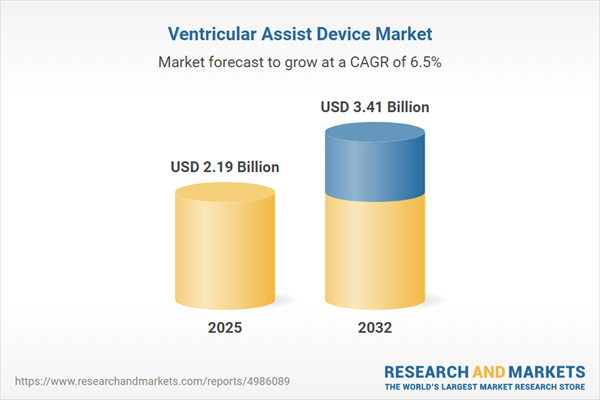Speak directly to the analyst to clarify any post sales queries you may have.
The ventricular assist device market is undergoing significant transformation, driven by advances in technology and evolving clinical practices across global healthcare systems. Senior leaders are assessing strategic pathways as demand for innovative mechanical cardiac support continues to grow.
Market Snapshot: Ventricular Assist Device Market Size and Trajectory
The Ventricular Assist Device Market grew from USD 2.06 billion in 2024 to USD 2.19 billion in 2025. It is expected to continue growing at a CAGR of 6.48%, reaching USD 3.41 billion by 2032.Scope & Segmentation
This report provides comprehensive coverage across the key domains influencing the ventricular assist device sector:
- Flow Class: Continuous Flow (Axial Flow, Centrifugal Flow), Pulsatile Flow
- Device Type: Biventricular, Left, Right
- Indication: Bridge to Recovery, Bridge to Transplant, Destination Therapy
- Product: External, Implantable
- End-User: Ambulatory Surgical Centers, Hospitals
- Geographies: Americas (United States, Canada, Mexico, Brazil, Argentina, Chile, Colombia, Peru), Europe (United Kingdom, Germany, France, Russia, Italy, Spain, Netherlands, Sweden, Poland, Switzerland), Middle East (United Arab Emirates, Saudi Arabia, Qatar, Turkey, Israel), Africa (South Africa, Nigeria, Egypt, Kenya), Asia-Pacific (China, India, Japan, Australia, South Korea, Indonesia, Thailand, Malaysia, Singapore, Taiwan)
- Leading Companies: Abbott Laboratories, Medtronic plc, Abiomed, Inc., LivaNova PLC, Berlin Heart GmbH, Jarvik Heart, Inc., CARMAT SA, CorWave SAS, Terumo Corporation, SynCardia Systems, LLC
Key Takeaways for Decision-Makers
- Emergence of advanced biocompatible coatings and pump designs is enabling earlier patient mobilization and reducing risks associated with device-supported therapy.
- Continuous remote monitoring and digital telemetry are shifting care models, allowing for timely interventions and reducing dependency on in-person visits.
- Collaborative production and sourcing strategies, in response to shifting trade environments, are improving operational resilience and supply chain efficiency.
- Diversified end-user profiles, from hospitals to ambulatory centers, are shaping both device configuration and deployment strategies to match distinct care environments.
- Manufacturers are focusing on product modularity and system interoperability to ensure seamless integration with evolving health technology infrastructure.
- Regional differences in healthcare infrastructure and reimbursement are driving the need for customized go-to-market strategies and investment in local stakeholder engagement.
Tariff Impact: Navigating Recent Policy Shifts
Newly implemented tariffs on key imported device components in 2025 have introduced additional complexity. Many original equipment manufacturers have responded by bolstering domestic supplier partnerships, reengineering components for cost efficiencies, and engaging with policymakers to advocate for medical technology exemptions. This environment incentivizes innovation in component design while underscoring the strategic importance of supply chain agility.
Methodology & Data Sources
This report utilizes a mixed-methods approach, combining structured interviews with leading clinical stakeholders and procurement executives, alongside secondary research from peer-reviewed literature, regulatory documents, and industry databases. Quantitative and qualitative insights were triangulated and stress-tested through expert panels to ensure robust, actionable findings.
Why This Report Matters
- Uncovers actionable market trends, supporting leaders in aligning investment with the most promising segments and technologies.
- Equips executive teams to respond proactively to shifts in tariff policy, supply chain risk, and changing reimbursement landscapes.
- Enables tailored commercial and clinical strategies through detailed segmentation and regional opportunity analysis.
Conclusion
Market stakeholders are positioned to benefit from aligning innovation, operational excellence, and regional strategy in the ventricular assist device arena. This report provides a foundation for informed planning that reflects the market's evolving complexity and strategic imperatives.
Additional Product Information:
- Purchase of this report includes 1 year online access with quarterly updates.
- This report can be updated on request. Please contact our Customer Experience team using the Ask a Question widget on our website.
Table of Contents
3. Executive Summary
4. Market Overview
7. Cumulative Impact of Artificial Intelligence 2025
Companies Mentioned
The companies profiled in this Ventricular Assist Device market report include:- Abbott Laboratories
- Medtronic plc
- Abiomed, Inc.
- LivaNova PLC
- Berlin Heart GmbH
- Jarvik Heart, Inc.
- CARMAT SA
- CorWave SAS
- Terumo Corporation
- SynCardia Systems, LLC
Table Information
| Report Attribute | Details |
|---|---|
| No. of Pages | 198 |
| Published | November 2025 |
| Forecast Period | 2025 - 2032 |
| Estimated Market Value ( USD | $ 2.19 Billion |
| Forecasted Market Value ( USD | $ 3.41 Billion |
| Compound Annual Growth Rate | 6.4% |
| Regions Covered | Global |
| No. of Companies Mentioned | 11 |









